Intel Unveils Meteor Lake Architecture: Intel 4 Heralds the Disaggregated Future of Mobile CPUs
by Gavin Bonshor on September 19, 2023 11:35 AM ESTSoC Tile, Part 1: Low-Power Island E-Cores, Designed for Ultimate Efficiency
Diving a little deeper into the SoC tile within Intel's Meteor Lake architecture, Intel hasn't just opted for a minor change but has made a significant leap forward, especially regarding I/O fabric scalability. The SoC tile itself isn't built on Intel 4 like the compute tile but is made by TSMC on their N6 node. Intel has ditched the old limitations of mesh routing by implementing a Network-On-Chip (NOC) on the silicon. This isn't just about making data lanes faster; it's about outlining smarter and more power-efficient access to memory. Likely an innovation from Intel's acquisition of NetSpeed back in 2018, which specialized in NoC and Fabric IP for SoCs, Intel opting for a physical NOC allows Intel to reduce the limits on bandwidth. Using EMIB and the nature of 2D scaling, the data paths are a lot shorter, translating into less power loss, but shorter wires also help reduce overall latency penalties.
Switching gears to low-power workload efficiency, Meteor Lake incorporates E-cores directly into the SoC tile, which Intel calls Low Power Island (LP) E-cores. Think of it as Intel's way of saying, "Why use a sledgehammer when a scalpel will do?". This means that the LP E-Cores are driven purely from a power-saving perspective. Having these LP E-cores available for workloads with the aid of Intel's Thread Director means lighter threads and background tasks that don't require the grunt of the P and E-cores on the compute tile can be directed onto the lower-powered LP E-cores.
While both the E and LP E-cores are based on the same Crestmont microarchitecture, the E-cores on the compute tile are built on Intel 4, along with the P-cores. The LP E-cores are made on TSMC's N6 node, like the rest of the SoC tile. These low-power island E-cores are tuned for finer-grained voltage control through an integrated Digital Linear Voltage Regulator (DLVR), and they also have a lower voltage-to-frequency (V/F) curve than the big E-cores on the compute tile, meaning they can operate with a lower power cost, thus saving power when transitioning low-intensity workloads off of the compute tile and onto the LP E-cores.
Part of the disaggregated nature of Foveros combined with individual power management controllers (PMC) within each tile means that IP blocks can be independently powered on or off when required.
SoC Tile: Bandwidth Scalability, Can't Stop The NOC
So adding a variety of tiles requires a highly competent pathing to ensure bandwidth is adequately structured. As I/O bandwidth bottlenecking was a major concern in previous iterations, Intel aims to solve bandwidth flow restrictions with a couple of solutions.
The first is through the scalability of the I/O bandwidth, which Intel does by adding what it calls 'Scalable Fabric,' which is configured for up to 128 GB/s of bandwidth throughput. All of the I/O ordering and address translation is fed through the IOC, while Intel has implanted a Network-on-Chip (NOC) to interconnect many of the different areas of the SoC.
The Network-on-Chip or NOC is designed to be coherent, and for Meteor Lake on Intel 4, this uses unordered processing, which moves data in an unordered fashion. Connecting all the tiles together through the NOC and independently through the IOC gives plenty of bandwidth headroom for devices or agents requiring it. The NOC is directly connected to the compute and graphics tile, while other elements, including the traffic fed directly through the LP E-cores on the SoC tile, media, display, the NPU, and the imaging processing unit (IPU), all going through the NOC. In terms of the connection to the I/O tile, this is connected directly to the IO fabric and then is fed through the IOC, which then goes directly to the NOC.
The SoC tile also integrates Wi-Fi 6E and can be made to support the latest Wi-Fi 7 standard. Having a future-proof method of including Wi-Fi 7 and Bluetooth 5.4 can add the next level of wireless connectivity to Intel's mobile platform. Wi-Fi 7 offers 320 MHz of bandwidth, doubling the channel width compared to its predecessor, Wi-Fi 6. It also uses 4096-QAM (4K QAM) to enable transmission speeds capable of hitting 5.8 Gbps.
We're still waiting for clarification on what this actually means. Whether it's supportive of Wi-Fi 7 or if there's some underlying compatibility within the Wi-Fi MAC integrated into the silicon. One option could be that Intel is adding a full external controller into the silicon to get to Wi-Fi 7 instead of CNVio splitting up parts of the radio stack. We have asked Intel for more details and will update you when we have a response.
That being said, Intel discloses 'support' for Wi-Fi 7 and BT 5.4, but there's a chance Intel could differentiate which wireless MAC is implemented into different chip segments. An example would be an Intel 9 Ultra SKU, bolstered by Wi-Fi 7 support, whereas a lower-end SKU like a Core 3 might utilize Wi-Fi 6E to save on cost.
Additional features include Multi-Resource Unit (RU) Puncturing and Military-grade security with WPA3 that supports GCMP-256 encryption to ensure both speed and security when connected to a wireless network. Unique features like Multi-Link Operation (MLO) in Wi-Fi 7 are designed to reduce latency and jitter by up to 60%, making it a competent solution for various user's connectivity needs. Adding Bluetooth 5.4 further complements this by improving audio quality, and it is claimed to offer up to 50% lower power consumption for longer battery life.
Also present on the SoC tile is the display controller and the media engine from the GPU. These are always-on (or at least, mostly-on) blocks that do not need to be built on a cutting-edge process node, making them good candidates to place on the SoC tile. Meteor Lake offers support for 8K HDR and AV1 video playback and contains native HDMI 2.1 and DisplayPort 2.1 connectivity.
Finally, the SoC tile also includes other key platform components, such as PCIe lanes, which are integral for connectivity to external devices such as discrete graphics cards and the platform's I/O capabilities, such as USB 4 and 3, as well as offering a direct interconnect to a separate I/O tile with Thunderbolt 4 and additional PCIe lanes. While we've touched on wireless connectivity, the SoC tiler also includes Ethernet support, although Intel hasn't disclosed yet which PHY will be included; it is likely to be capable of 2.5 GbE at the minimum.
A Note on Meteor Lake's Security Features: New Silicon Security Engine (ISSE)
Security has also been given closer attention in Meteor Lake. The architecture introduces the Intel Silicon Security Engine (ISSE), a dedicated component focused solely on securing things at a silicon level. Various vulnerabilities have been at the forefront of media over the last few years, including Meltdown, Spectre, and Foreshadow.
With real threats around the world, securing data is ever prevalent, and CPU architects and designers not only need to consider performance and efficiency, but security and doing some architecturally is just as important as a competent software stack. The Converged Security and Manageability Engine (CSME) has also been partitioned to further enhance platform security. These features collectively work to give a wide range of on-chip and off-chip securities designed to mitigate attacks on multiple fronts.


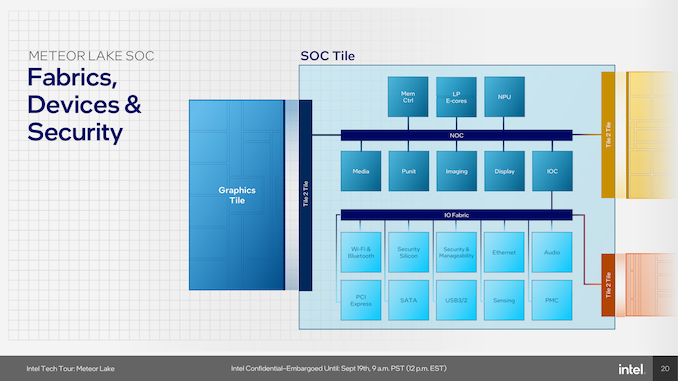
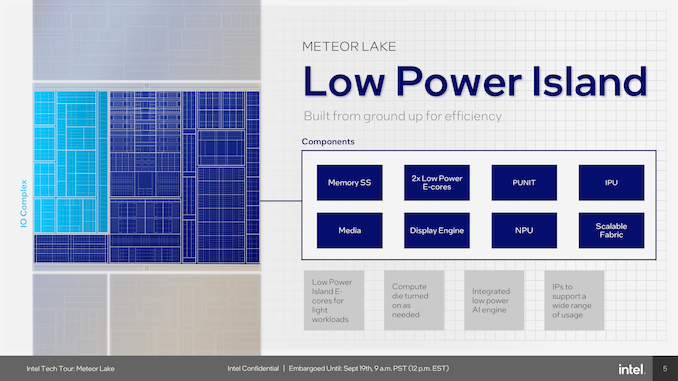
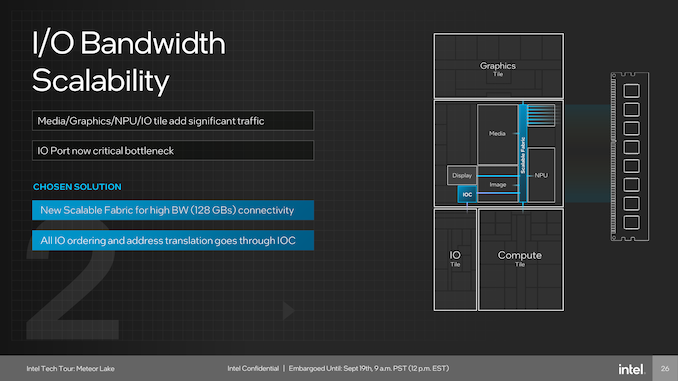
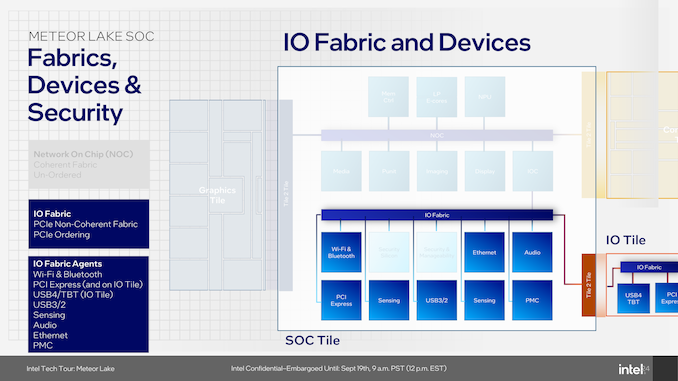
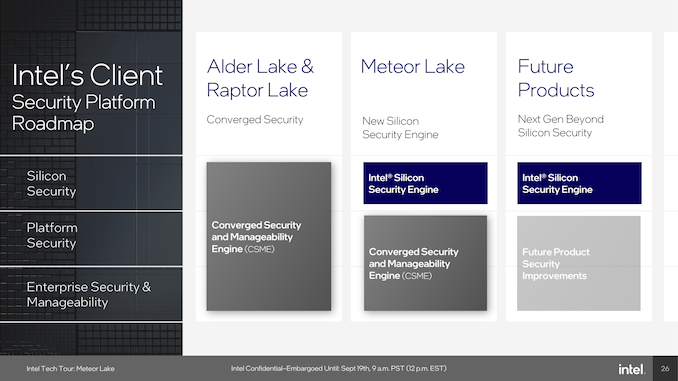








107 Comments
View All Comments
FWhitTrampoline - Thursday, September 21, 2023 - link
That would be more of DIY friendly Very Small Form Factor Enthusiast/end user there! And with a reasonable expectation that the vibrant DIY Small Form Factor devices(Mini desktop PCs) market continue to be offered Socket Packaged Processors with newer than Ryzen 5000G/Zen-3 and Vega 8CU iGPU based graphicsIP, and Ditto for any Intel based options as well.
So it's wrong to expect any Further Ryzen G series Desktop[Socket Packaged] APUs from AMD because that's not good for the OEMs there and their business models that are not so DIY friendly for Processor Upgrades if the Processor comes BGA wedded to the Motherboard! And OEM products that are not so good for eWaste reduction because if the processor goes that can not be easily replaced/upgraded by the end user(DIY sorts of Folks).
There needs to be a Right to Processor Upgrade just as much as a Right to Repair and with Socket packaged processors those rights go hand in hand there along with any environmental eWaste concerns. But we must not trample upon those Business Models as that's just not good for OEM Profits there, consumers be damned!
And InWin Chopin or ASRock Desk Mini, Socket Packaged APUs/SOCs are the best option as that's by definition DIY friendly there.
I'll expect no Complaints from you if the entire PC market goes BGA Packaged Processors only and you'll have to buy the Processor Attached to the Motherboard, take it or leave it!
brucethemoose - Wednesday, September 20, 2023 - link
> That might make a really nice media playerSeems like a lot of silicon for what's essentially the job of a dirt cheap ARM SoC. And its a questionable fit for a headless system unless its like a stable diffusion/transcoding host.
It *does* seems like an interesting fit for a smart TV chip, maybe with a small GPU die, as they would actually use the NPU for their internal video filtering.
emvonline - Tuesday, September 19, 2023 - link
Intel 4 will not be shipping any products to customers until Mid December. This after stating it is in production in December 2022. 12 months from production starts to PCs out is not good. And I better be able to buy meteor lake Notebook on Dec 14th 2023 or this is exactly like old Intel (Launch means we may have sold some parts to someone somewhere). This claiming a node is done when its production ready, when you ship nothing is problematic. FYI Meteor Lake is 2x the cost of Raptor lake in 2024. Intel 4 is not a cost reduction. The product might be great but it is expensiveRoy2002 - Tuesday, September 19, 2023 - link
4 was in production in December 2022? No way! It should be started not long ago.Usually the first real product silicon would be taped out one year ahead of release date. And that silicon would be very buggy and needs several steppings to have bugs fixed.
Roy2002 - Tuesday, September 19, 2023 - link
So December 2022 is the initial project tapein date and silicon debug follows.ChrisGar15 - Tuesday, September 19, 2023 - link
Probably called "manufacturing ready."xol - Wednesday, September 20, 2023 - link
So Xe-lpg is still intel uhd graphics (13\14th gen now?) with top EU count of 128 up from 96. Fine.maybe about 3TF fp32, not quite xbox Series S level
They added RT support which is good i guess but will it ever be used in a gpu that is really PS4 performance?, or maybe there are not gaming applications.
product sounds good, just wait for the numbering scheme
JBCIII - Wednesday, September 20, 2023 - link
"An example of how applications pool together the various tiles include those through WinML, which has been part of Microsoft's operating systems since Windows 10, typically runs workloads with the MLAS library through the CPU, while those going through DirectML are utilized by both the CPU and GPU."This sentence is really a mess. Editor: please take note. Is "example" the subject of "include"? That would make "includes" the necessary form of the verb. What is the subject of "runs"? I'm guessing WinML. Maybe it should be "WinML...which typically runs" but the long parenthetical expression about Windows 10 support makes it hard to bridge the gap. Maybe parentheses would be more clear instead of commas to keep the meaning on track. I'm still not sure what was meant.
GeoffreyA - Thursday, September 21, 2023 - link
WinML is the higher-level abstraction, and DirectML, the lower-level one.Kevin G - Wednesday, September 20, 2023 - link
This is what I was hoping to see Intel pull off in the late 14 nm/early 10 nm days when their foundries were having difficulties. Intel should have pivoted int his direction at the first sign of trouble with those as the packaging side of this, while cutting edge back then, could have been pulled off. Better late than never.However with Meteor Lake around the corner, it is shaping up to a pretty good design. Both the CPU and GPU sides can scale and evolve independently from the central SoC. The GPU portion that was moved onto the SoC makes sense as the codecs and display logic are not going to change over the next few generations. I would quibble about the point made that putting them next to the NPU is more advantageous than next to the GPU cores. There certainly is a benefit for AI upscaling of movies but my presumption is that I'd be lower power/lower latency to have the encoders next to the GPU cache which houses the final render frame for encoding and transmission. The tasks that's benefit here would be gaming streaming or remote access. Both things can be true hence why it is a quibble as it'll matter to individual use cases which one approach is superior.
My initial presumption for the IO die was that it was to house various analog circuits that would then be leveraged by the SoC die. This is a clever means of process optimization as analog circuitry does not scale at the same rate as logic. Similarly this would permit a cheaper die to extend the number of area intensive IO pads.
The last thing missing is the L4 cache die that was hinted at in earlier Linux patches. That'll probably come along with the Lunar Lake generation.